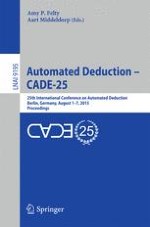2015 | Book
Automated Deduction - CADE-25
25th International Conference on Automated Deduction, Berlin, Germany, August 1-7, 2015, Proceedings
Editors: Amy P. Felty, Aart Middeldorp
Publisher: Springer International Publishing
Book Series : Lecture Notes in Computer Science
